Search Posts
Recent Posts
- Rhode Island Weather for May 21, 2025 – Jack Donnelly May 21, 2025
- Time for Sour Grapes! May 21st – Tim Jones May 21, 2025
- It is what it is: May 21, 2025 – Jen Brien May 21, 2025
- The RI Senior Games 2025 – “We need players!” May 21, 2025
- Another kerfuffle where strikers’ rights meet rights of children, elderly, homeowners, drivers May 21, 2025
Categories
Subscribe!
Thanks for subscribing! Please check your email for further instructions.
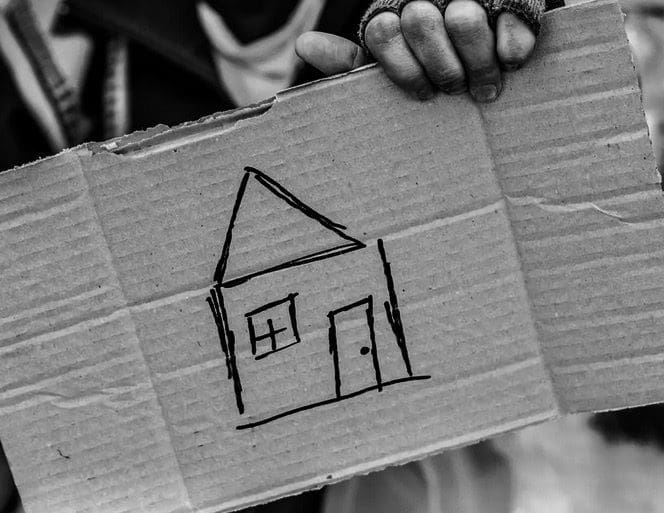
Homeless in RI: Housing “czar” resigns, couples shelter, Armory complaints, Pallet shelters
RI’s First Housing Secretary steps down same day as scathing reports on conditions at Cranston Street Armory come to light
Statement of Matt Sheaff, Governor McKee’s office:
“Governor McKee has accepted the resignation of Housing Secretary Josh Saal.
Housing is one of the most critical issues facing Rhode Island today and over the next decade. That’s why our Administration proposed a historic quarter billion dollar investment in creating and supporting more housing at all income levels. This issue is crucial to the families struggling today and to the long-term economic success of our state.
We thank Secretary Saal for his work over the past year and look forward to building a Department of Housing that is innovative and responsive to the gravity this moment requires.”
Secretary Saal has agreed to stay on for a short transition period and our office will have more to say about a leadership plan for the Department over the next few days.”
Several factors may have led to the Governor losing confidence in Saal’s leadership, with items piling on one another this week – failure to complete a required report on time, and then turning it in in an incomplete way – and the complaints about the conditions of the Armory – as well as continued non-communication with the media either directly or through an public relations consulting group. He was highly faulted for lack of communication among the myriad of housing and social service groups as well.
January 12th, at 5pm, Senator Lou DiPalma will hold a public hearing on the homeless crisis and the funds allocated for housing and their status.
Saal had served as Deputy Commerce Secretary before the position was elevated to a cabinet level, prior to assuming this position almost a year ago, and his salary was set to grow to approximately $190K. Prior to this he had worked in NYC in affordable housing and is said to have worked well in the field, developing over 8,000 housing units.
Here is his resignation letter:
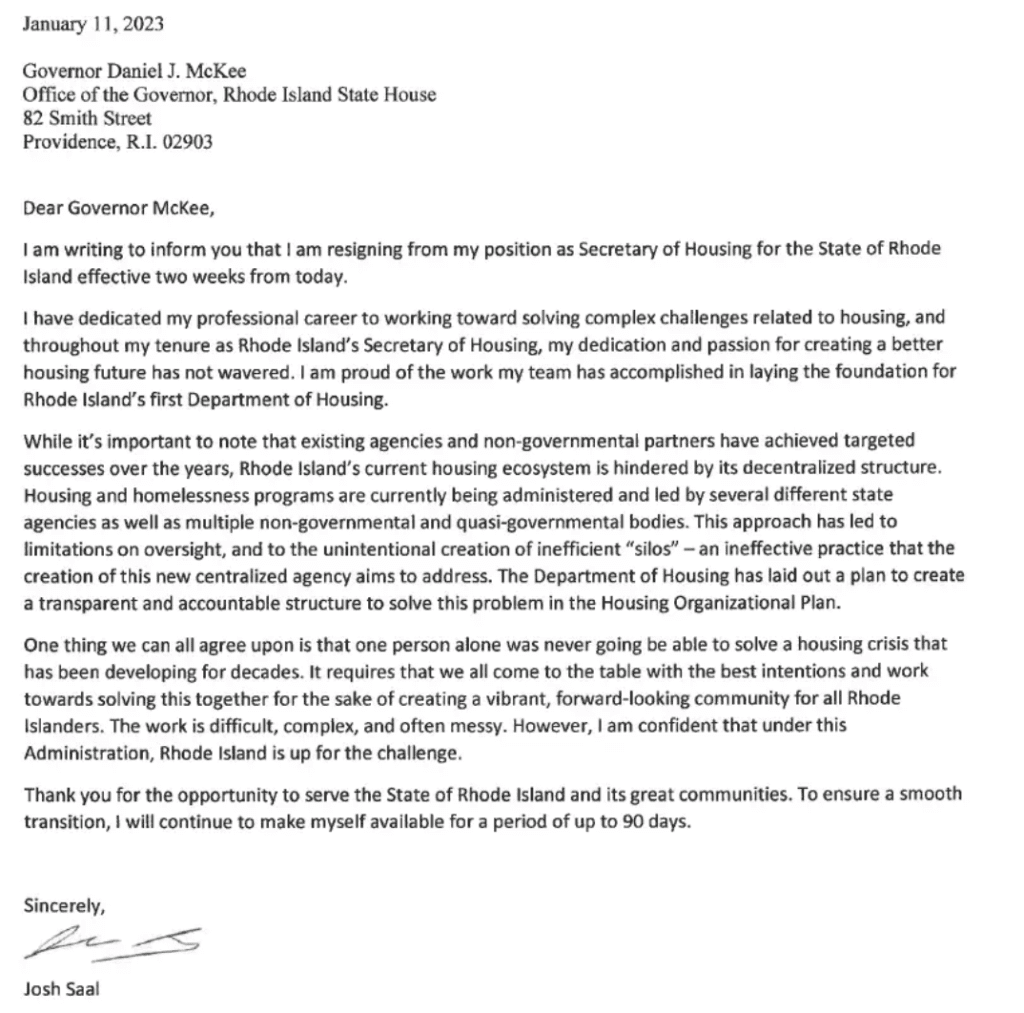
Speaker of the House, Joseph Shekarchi said, “We need immediate production and I look forward to working with Gov. McKee and a new secretary. The time to act is now!”
House Minority Leader Michael W. Chippendale offers the following statement on the resignation of Housing Secretary Josh Saal: While Secretary Saal’s resignation is not a surprise and is appropriate given the revelations of the past few weeks, it has definitely driven home the need to have an experienced professional in the Housing Secretary role – someone who understands the unique needs and landscape of Rhode Island. Rhode Island’s critical affordable housing shortage is worthy of a leader who can make an immediate impact forging alliance with the various support organizations across the state and building consensus for a thoughtful plan of action.
The name of Stefan Pryor has been suggested by some officials as a possible replacement. Pryor headed CommerceRI before resigning to run for Treasurer of RI, which was unsuccessful. He has not announced another position.
_
Hartford Avenue Couples Shelter

A vacant building at 662 Hartford Avenue in Providence, owned by the Rhode Island Department of Behavior Healthcare, Developmental Disabilities & Hospitals (BHDDH) will become a 24/7 shelter for the homeless with 40 beds, increased from 16 originally proposed in 2022. The shelter opening is planned for the end of January, primarily as an Emergency Couple’s Shelter, with priority for unhoused couples, though it will be open to others.
A handout about the shelter said “This shelter is open to all populations but cannot serve SOs due to nearby school system. “SOs” or registered sex offenders. They cannot be served in the Hartford Avenue shelter because the facility is .2 miles from a middle school school (DelSesto Middle School) and .9 miles from an elementary school (Anthony Carnevale Middle School). It is not clear how people will be screened to assure they are not sex offenders.
No cooking will be allowed on site and food must be brought in. There will be bathrooms and a mobile shower unit, similar to that being used at the Cranston Street Armory.
Crossroads will work within the Coordinated Entry System to identify and serve those individuals and couples with the highest acuity.
In announcing the shelter, Josh Saal, RI Department of Housing Secretary said, “While the only long-term solution to ending homelessness in Rhode Island is to build more permanent housing, it is critical that we continue to make immediate investments in low-barrier resources that make warm shelter and much-needed supportive services more accessible to more individuals in need.”
Karen Santilli, CEO of Crossroads said, “While our most urgent priority is ensuring the health and safety of our shelter guests, we are equally focused on providing shelter guests with support and resources to find permanent housing.”
_
Cranston Street Armory complaints – “this is not a shelter…”
Those who are taking up residence at the Cranston Street Armory have taken their complaints to the media, with all 3 television stations doing stories and sharing photos of poor living conditions. The shelter, designed to hold 40-90 people has now expanded to 150 and as many as 200 according to sources on some nights. Cots originally ran out and people slept on the floor, though Amos House, the group running the shelter says now all people have access to cots.
The facility does not have bathrooms for people to use, though some residents have said that there is one bathroom only “some” people can use. Otherwise, mobile bathrooms and a mobile van shower service are provided. The shower service reportedly comes three times a week.
Media interviews (see above and click on the link to watch NBC10’s) have exposed some of the conditions at the Armory, including photos of bathroom areas soiled in excrement, and food said to be left out for hours. Residents have said there is nowhere to wash your hands or brush your teeth and the showers aren’t frequent enough. He called the shelter conditions “terrible”. and that you have to be prepared to fight for yourself as people are doing drugs and using alcohol.
There are claims that overdoses are happening every day, and alcohol and drug paraphernalia are coming in and out of the building, even though none are said to be allowed on the premises. NBC10 interviewed the Medical Director of Amos House, Dr. Rahul Vanjani said that the “shelter” is meant for people to come in out of the cold, and NOT to be living there – “this is not a shelter, this is not a residence, this is a warming shelter, a place for people to come in out of the cold”. We’ve requested a clarification from Amos House and the state as well as from Amos House, though according to the television report “organizers have said they are overwhelmed with the number of people”.
Eileen Hayes of Amos House had said at the opening of the shelter that recruiting adequate staffing was a problem, and National Guard are seen to be still at the site.
From the very beginning of the shelter, what to call it was a clarifying point by state officials, but without an explanation as to what it means. Traditionally shelters have beds or bunk beds. The Armory has green cots, with stretched canvas over the frames, and not mattresses or linens. Officials emphasize this is not a shelter but a warming station. The difference appears to be a warming station is a place to come in out of the cold on a temporary, sporadic basis and not a place to “call home” on a temporary or emergency basis. Other than the beds vs. cots, and outside bathrooms and showers, the designation does not mean cleanliness standards would be different.
Another person living at the shelter said “overdoses are happening left and right” and the next day the same people are allowed back into the shelter. One person said, “it’s like the wild, wild west here – you best be ready to fight in a moment, dodge a needle, or hope you make dinner”.
Emmanuel House – helped helping others

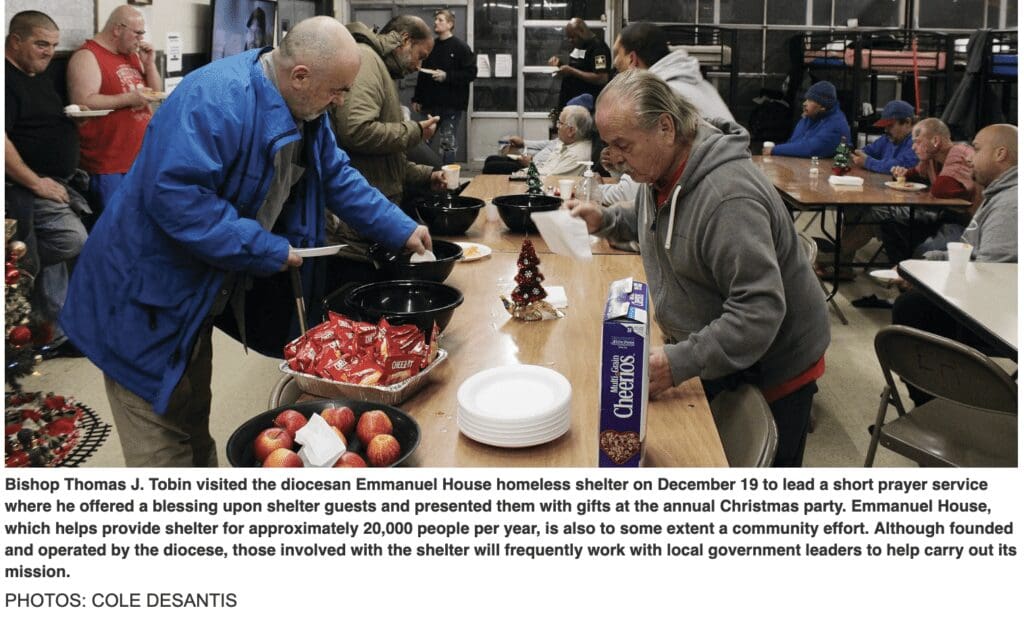
The Diocese of Providence continues to manage its shelter program at Emmanuel House in Providence. They say they serve approximately 20,000 people per year, and praise their relationship with the state and leaders. Photo shows Bishop Tobin talking with the men living there. He later gave out Christmas gifts and led the group in prayer. They point to their success – “the core of Emmanuel House’s mission is inspired by the traditional social and moral teachings of the Church. The mission of the Emmanuel House, like all of the programs associated with the Office of Catholic Charities and Social Ministry, is “rooted in the social teachings of the Catholic Church,” Jahnz stated, noting that the mission of the Emmanuel House “follows straight from the Gospel call we receive in Matthew 25 of helping those in need.”
Report filed gets an “I” for incomplete
Most of the discussion over the last few days had to do with Josh Saal, the Housing “Czar” not turning in a required report on time (Dec. 31, 2022), and when he did turn it in (Jan. 5, 2023) it was incomplete with much of the required data sections filled in from the Census or existing data sources, and not originally researched. While some politicians have called for his firing, including Rep. Chippendale, Speaker Shekarchi said he wants the opportunity to meet with him and ask him his side of the story and what he needs to do the job. Saal has said the report data will be included when he completes the state Housing Plan. Funding for Saal’s department wasn’t included until the 2023 budget, starting on January 1st, 2023.
___
Pallet Shelters – the next big thing in homelessness – national marketing push
The little white sheds as a homeless solution, albeit for next year, are on the horizon. Attempts to put them up in Rhode Island have failed for 2-3 years, but discussion is already building to buy the sheds – called Pallet Shelters – for the following year. Emergency housing shelters at the Armory and elsewhere are set to be closed in April of 2023. Being “at the ready” for next year’s homeless influx has creative minds are turning towards establishing little villages of pallet shelters. The cost to purchase a standard shed sleeping one is approximately $8,000 each. Then there is setting up electricity, and heat. Also, remote bathrooms and mobile shower huts are available. The pallet shelters can all be locked and residents can take their key with them when they leave. Food delivery is required as there is no cooking in the sheds.
According to the company, thousands of people in 63 shelter communities – or villages – across the country have used the company’s units.
When plans were initially discussed to have the sheds put on the grounds of the Pastore Complex, state-owned land in Cranston, the local community opposed the idea given that the city already has Harrington Hall residents who have to leave the shelter from 7am to 5pm every day. Cranston also provides fire, police and EMS response to the facility. The Cranston City Council considered a resolution to go to Governor McKee asking him not to locate any more housing for the homeless in the city which was not voted to move forward, but taken as NIMBY-ism.
Unexpected Cost of Pallet Shelters villages
According to a Los Angeles blog which has experience with Pallet Shelter villages: “The problem is that these cramped huts offer only a small step up from that in terms of quality of life. That minimal improvement comes with an eyewatering price tag. Cities end up blowing their budgets on next to nothing when they could invest just a little more to have safe, affordable, permanent housing options.”
“Pallet advertises their 8×8, two-bed shed as costing just under $7,000. But the city of Los Angeles has spent $48,452,115 on constructing 11 different “tiny home villages” with 1,252 beds total. That’s 626 units at most. So the cost per hut comes to a staggering $77,399.54.
But that’s not all – there is also a $25,133,900 annual cost to operate these sites. Now we’re talking about a $3,345 ongoing monthly cost for a one-room shelter made out of plastic.”
In an article in New York Magazine: “And while the design of the home — which is, admittedly, more garden shed than prefab accessory dwelling — has elicited strong criticism from some in the unhoused community, there is more concern about the fact that the villages are being built as temporary housing with nowhere permanent to go.”
Shayla Myers of the Legal Aid Foundation of LA: “The city keeps investing in these temporary shelters, but everyone acknowledges that there’s nowhere to move to from these shelters. And if it’s not permanent housing, it doesn’t actually solve homelessness. Everyone says we need all of these options, and there’s no question that’s true. But at some point, the level of investment that’s going into temporary shelters starts to supplant permanent solutions.”
In Santa Ana, California, local residents have said that their city has been a “dumping ground for too long” for homeless shelters. So much so that the city has taken legal action to fight what it considers to be an unfair allocation of homeless services throughout Orange County. The city this week filed a lawsuit against Orange County and three south county cities, alleging they are not doing their fair share to provide shelters and are relying instead on Santa Ana to house the homeless.”
Pallet Shelter has adjusted their website adding units that are community rooms, and units with up to 4 beds:
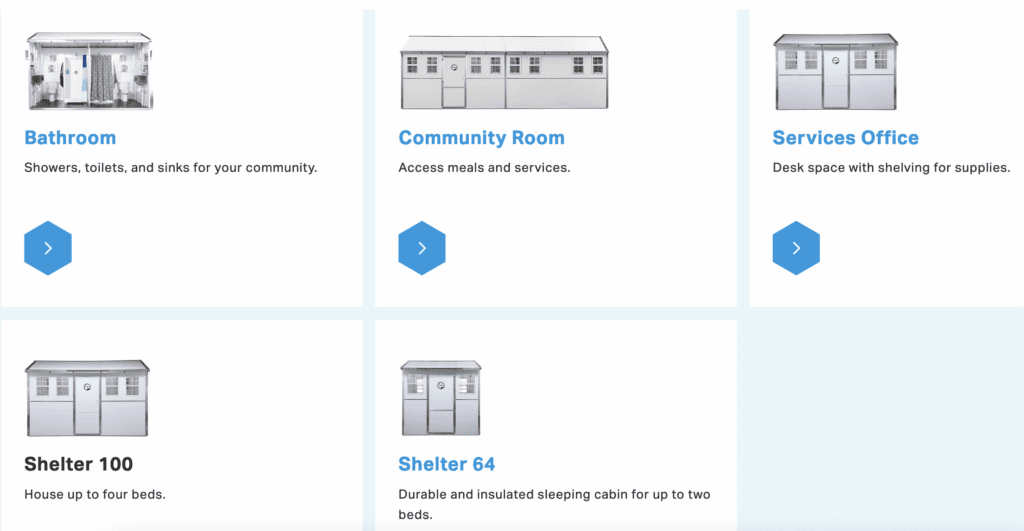
They have also added a section on how to build a village, and included a suggested layout:
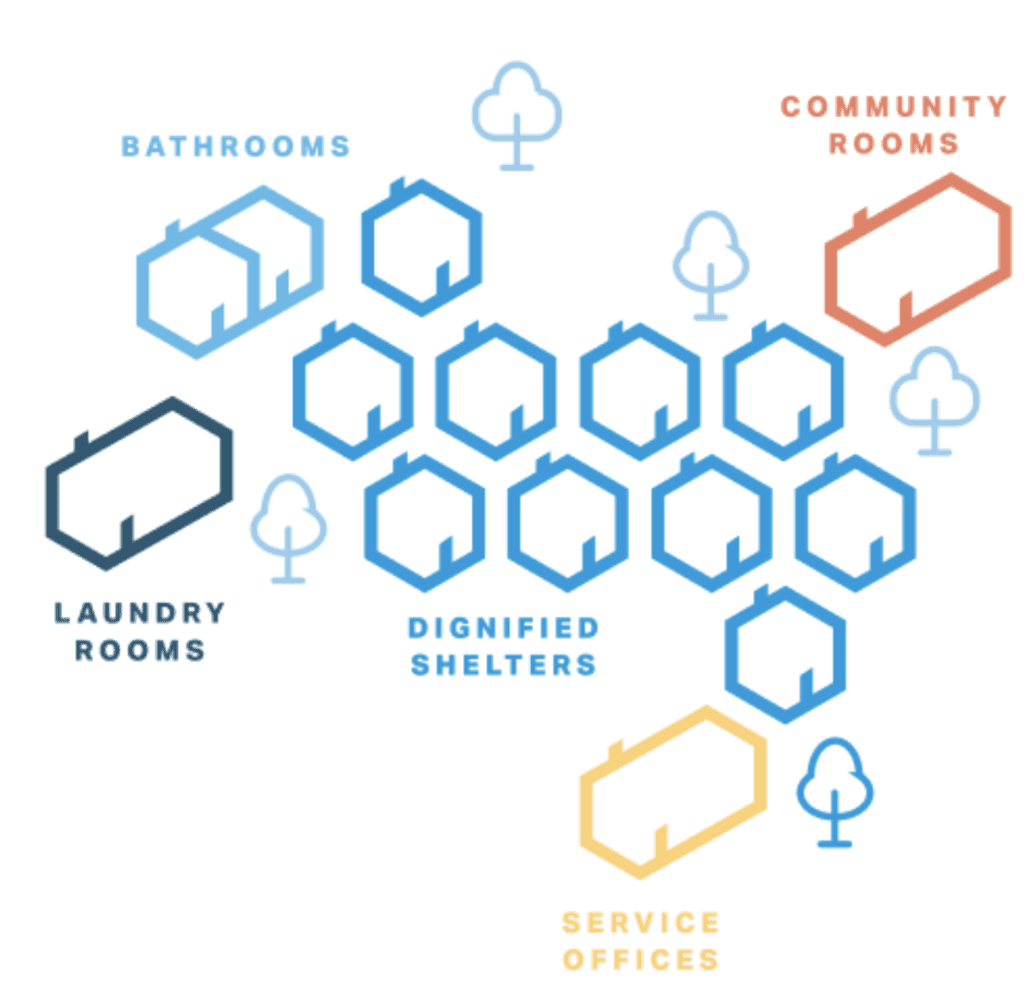
Funding of Pallet Shelters
The site includes suggestions of how to fund the Pallet Shelter villages including a combination of ARPA federal funds, state funds, private donations, and general funds.
Pallet Shelter built its 100th village a few days ago – in Tulip, Washington.
___

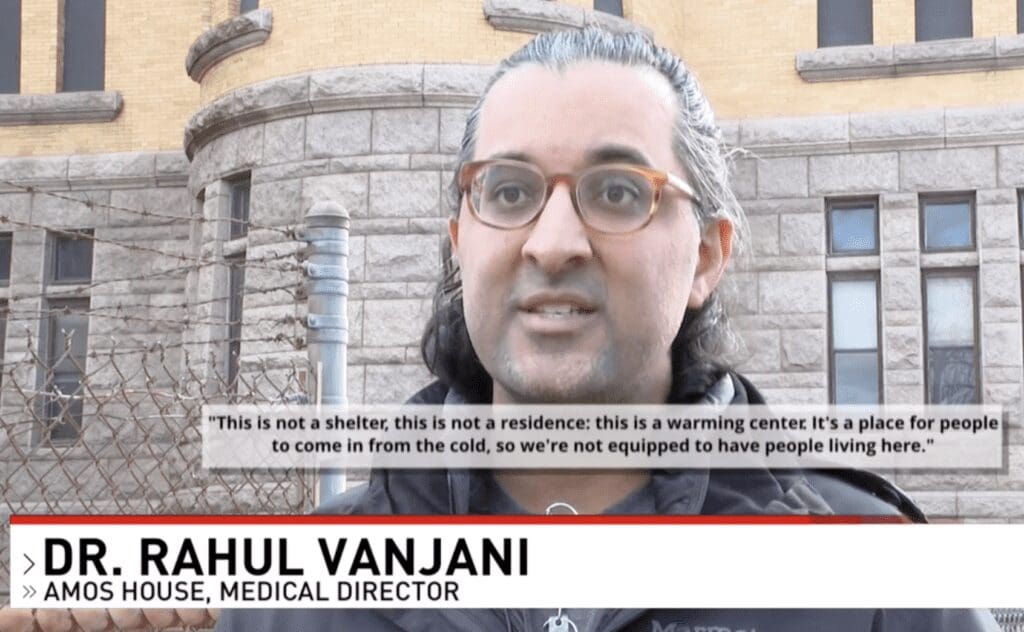
Two words: Quonset Huts! I’m no expert, though I’m willing to bet they could be a far less expensive option and be more of a longer term residence than the Pallet option. A quick Google search shows how these durable shelters can be aesthetic, lasting option.
It might be a very good option. Oddly enough (?) some people resist being isolated in a closed up area so having other people around is a positive – and then again, others feel the opposite. The Point in Time count happening soon should include questions about “what would make you resist taking housing” to identify these problems, so they can be addressed.